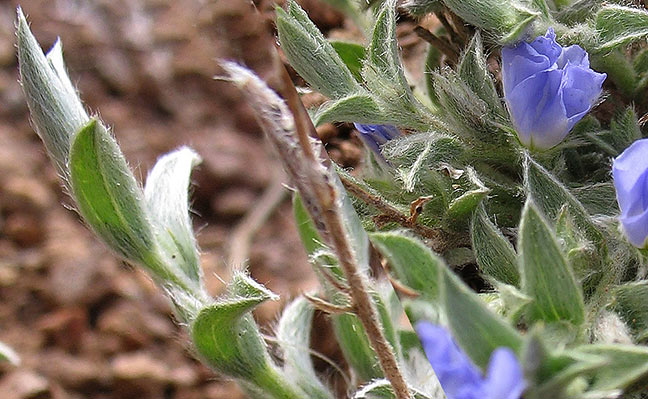
E. sericeus leaves photographed in the field in bright sun; (top) first held to be backlit & (bottom) then with only incidental backlighting [Hays Co.]. Handheld photo taken with a Canon Powershot A610, macro mode. [click for enlargement]


Given that leaf venation of Evolvulus taxa is only sometimes apparent in normal reflective lighting, using this feature in the field might not seem feasible, an interesting but not practical differentia, requiring laboratory techniques (i.e., clearing) or special equipment (high resolution scanners with backlit capability). But if the leaves of different taxa differ in the manner in which light (a) passes through them and (b) the way in which veins transmit the light, then it might nonetheless be possible to view and photograph these differences in the field.
Unfortunately this possibility occurred to me only in October 2012, when only fresh E. sericeus leaves were available. The above photo with two views of the same leaves reveals the relatively strong transparency of E. sericeus leaves. Even with leaves not directly backlit the secondary veins appear to pick up and transmit light from below.


 |
 |

|

|
|---|---|---|---|
| Hidalgo Co. | Hays Co. — rightmost is with reflective light | ||
I also rigged a structure that would permit directing the light through the leaves via translucent onionskin paper. The small window and additional structure reduced ambient light from the other side of the leaf.

I tested this with four rehydrated leaves, using the Canon Powershot A610, macro mode. One leaf was from E. purpusii, a species said to have 'nervation [other than midrib] invisible' [van Ooststroom 1934: 146], the others, E. sericeus (2 from Hays Co., 1 from Jeff Davis Co. in the Trans-Pecos — collected as a dead dry brittle stem that was rehydrated in the field). I give the glabrous upper surface for each leaf.
Although the E. purpusii leaf is not as translucent as the others, the backlighting show that it has the same basal acrodromous venation as E. sericeus. It also shares the unique vestiture asymmetry common with that species (as well as forms with pubescence on both surfaces). [To compare the same leaf, dry with reflective lighting.] The Jeff Davis leaf has two strong pairs of secondary veins; those from Hays Co. only one strong secondary pair from the base (with a second pair on the broader leaf).

E. purpusii, Nuevo León, Oct. 1990 |

E. sericeus, Jeff Davis Co., February 2012 |

E. sericeus, Hays Co., 30 Sept. 2012 |

E. sericeus, Hays Co., 1 Nov. 2012 |
|---|